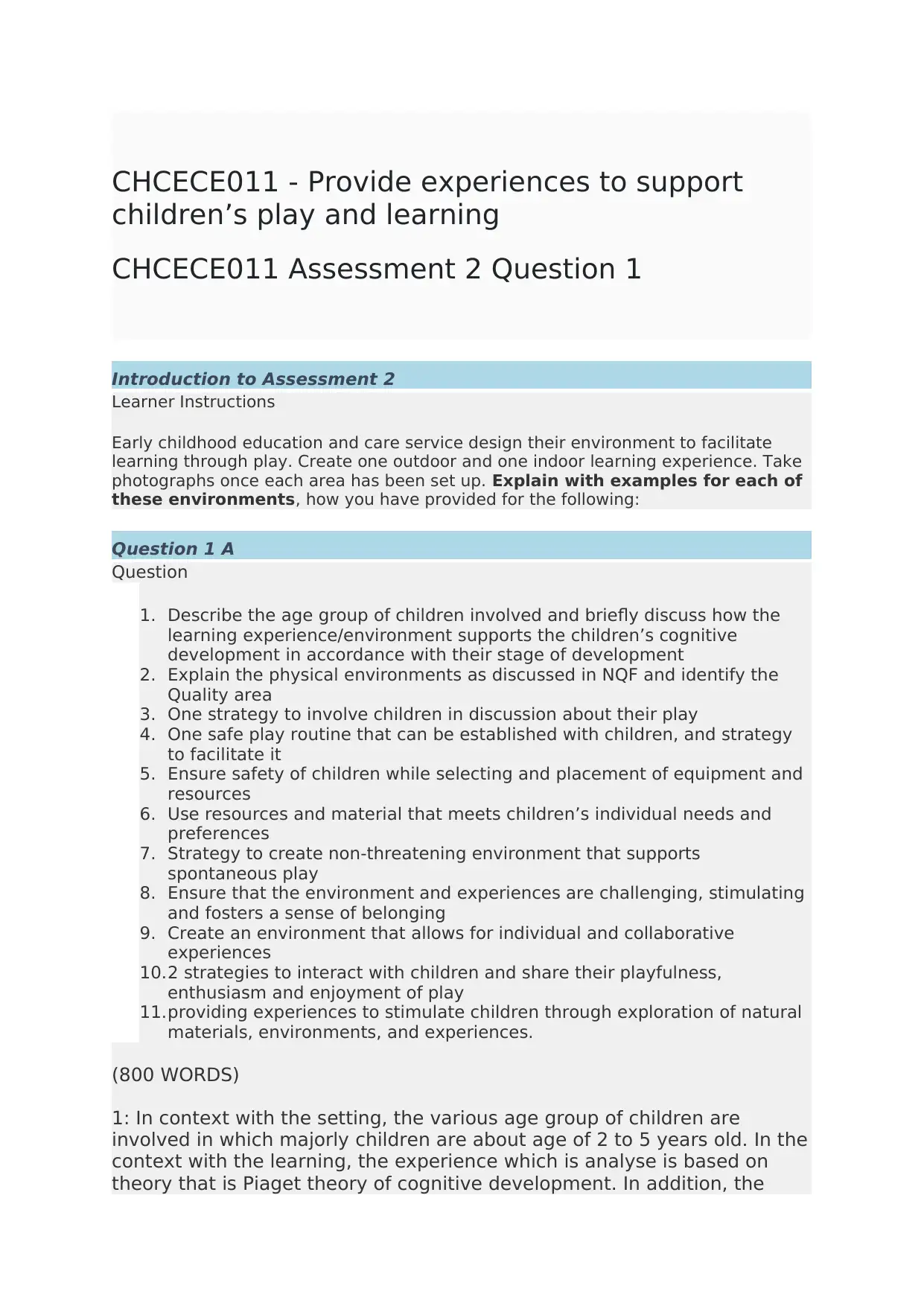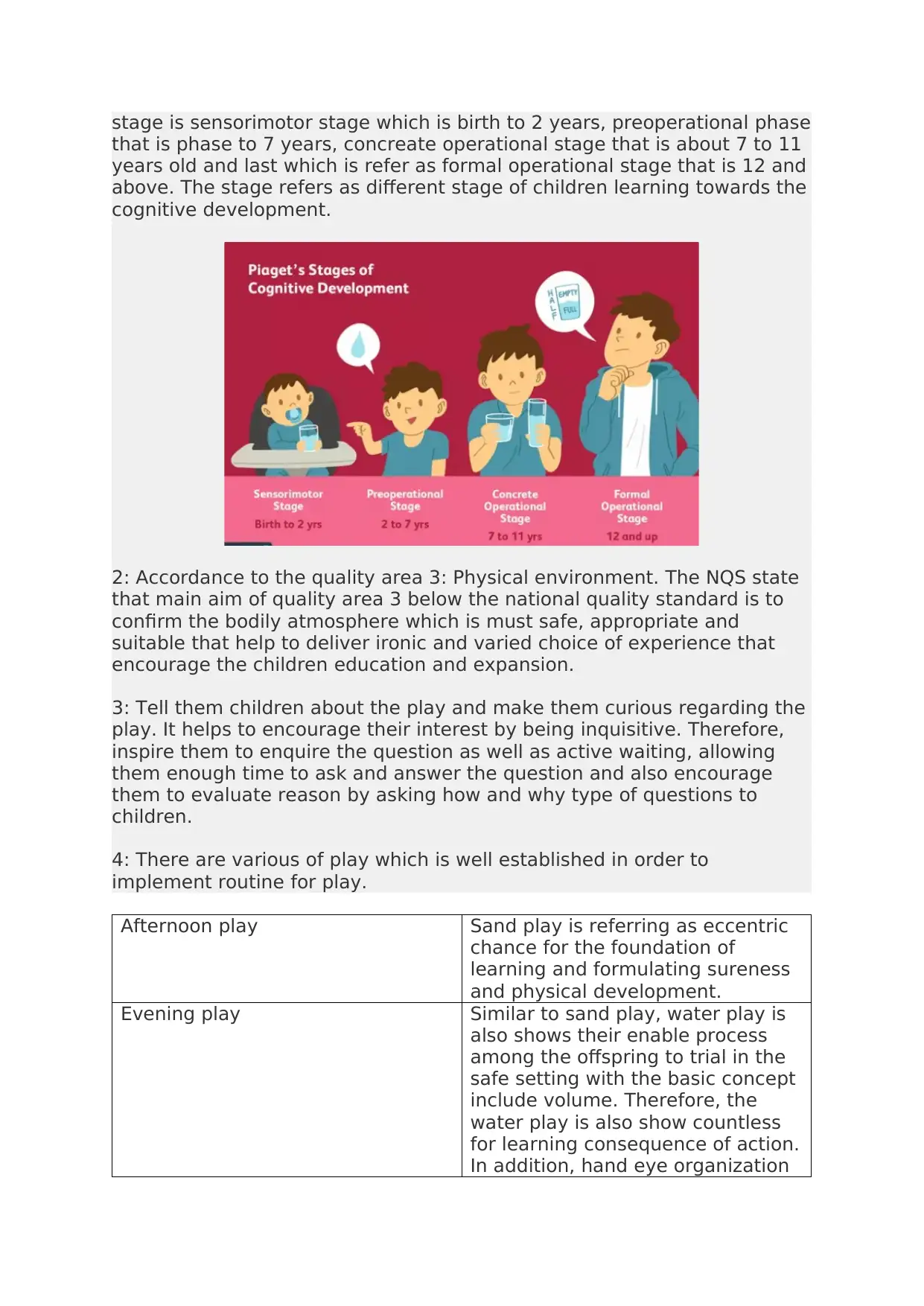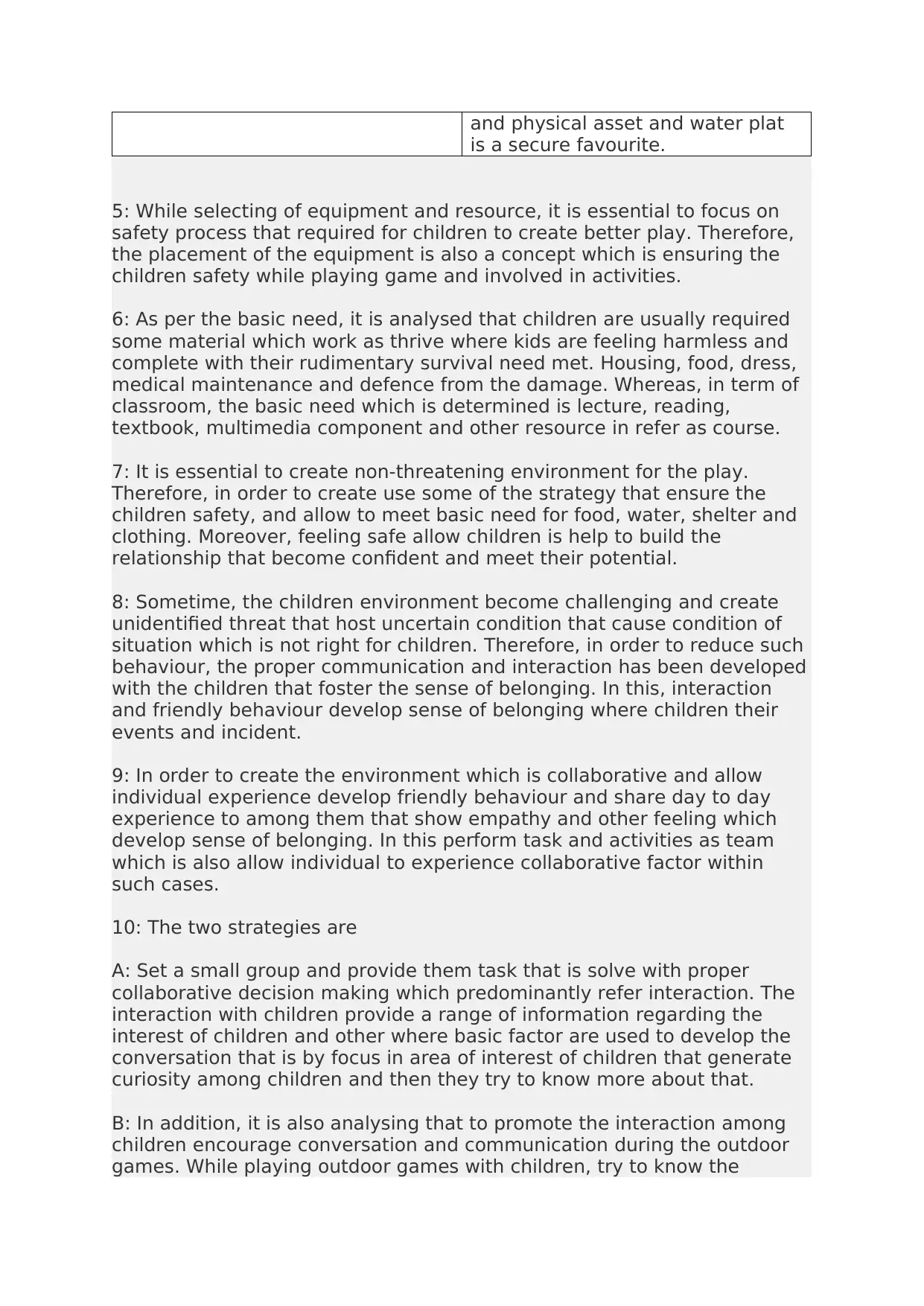CHCECE011 - Assessment 2: Providing Play and Learning Experiences
VerifiedAdded on 2023/06/05
|4
|1194
|267
Homework Assignment
AI Summary
This assignment, focusing on CHCECE011, explores the creation of both indoor and outdoor learning environments designed to support children's play and cognitive development. The document analyzes the learning experiences for children aged 2 to 5, aligning with Piaget's theory of cognitive development, and emphasizes the importance of understanding the sensorimotor and preoperational stages. The assignment addresses key aspects such as physical environments in accordance with the NQF, strategies to facilitate discussions about play, and establishing safe play routines. It also highlights the significance of selecting safe equipment, meeting children's individual needs, creating non-threatening environments, and fostering a sense of belonging. The document provides strategies for encouraging both individual and collaborative experiences, as well as interactive techniques to share enthusiasm for play. Finally, it underscores the value of providing experiences that stimulate children through exploration of natural materials and environments, promoting their understanding of the world around them.

CHCECE011 - Provide experiences to support
children’s play and learning
CHCECE011 Assessment 2 Question 1
Introduction to Assessment 2
Learner Instructions
Early childhood education and care service design their environment to facilitate
learning through play. Create one outdoor and one indoor learning experience. Take
photographs once each area has been set up. Explain with examples for each of
these environments, how you have provided for the following:
Question 1 A
Question
1. Describe the age group of children involved and briefly discuss how the
learning experience/environment supports the children’s cognitive
development in accordance with their stage of development
2. Explain the physical environments as discussed in NQF and identify the
Quality area
3. One strategy to involve children in discussion about their play
4. One safe play routine that can be established with children, and strategy
to facilitate it
5. Ensure safety of children while selecting and placement of equipment and
resources
6. Use resources and material that meets children’s individual needs and
preferences
7. Strategy to create non-threatening environment that supports
spontaneous play
8. Ensure that the environment and experiences are challenging, stimulating
and fosters a sense of belonging
9. Create an environment that allows for individual and collaborative
experiences
10.2 strategies to interact with children and share their playfulness,
enthusiasm and enjoyment of play
11.providing experiences to stimulate children through exploration of natural
materials, environments, and experiences.
(800 WORDS)
1: In context with the setting, the various age group of children are
involved in which majorly children are about age of 2 to 5 years old. In the
context with the learning, the experience which is analyse is based on
theory that is Piaget theory of cognitive development. In addition, the
children’s play and learning
CHCECE011 Assessment 2 Question 1
Introduction to Assessment 2
Learner Instructions
Early childhood education and care service design their environment to facilitate
learning through play. Create one outdoor and one indoor learning experience. Take
photographs once each area has been set up. Explain with examples for each of
these environments, how you have provided for the following:
Question 1 A
Question
1. Describe the age group of children involved and briefly discuss how the
learning experience/environment supports the children’s cognitive
development in accordance with their stage of development
2. Explain the physical environments as discussed in NQF and identify the
Quality area
3. One strategy to involve children in discussion about their play
4. One safe play routine that can be established with children, and strategy
to facilitate it
5. Ensure safety of children while selecting and placement of equipment and
resources
6. Use resources and material that meets children’s individual needs and
preferences
7. Strategy to create non-threatening environment that supports
spontaneous play
8. Ensure that the environment and experiences are challenging, stimulating
and fosters a sense of belonging
9. Create an environment that allows for individual and collaborative
experiences
10.2 strategies to interact with children and share their playfulness,
enthusiasm and enjoyment of play
11.providing experiences to stimulate children through exploration of natural
materials, environments, and experiences.
(800 WORDS)
1: In context with the setting, the various age group of children are
involved in which majorly children are about age of 2 to 5 years old. In the
context with the learning, the experience which is analyse is based on
theory that is Piaget theory of cognitive development. In addition, the
Paraphrase This Document
Need a fresh take? Get an instant paraphrase of this document with our AI Paraphraser

stage is sensorimotor stage which is birth to 2 years, preoperational phase
that is phase to 7 years, concreate operational stage that is about 7 to 11
years old and last which is refer as formal operational stage that is 12 and
above. The stage refers as different stage of children learning towards the
cognitive development.
2: Accordance to the quality area 3: Physical environment. The NQS state
that main aim of quality area 3 below the national quality standard is to
confirm the bodily atmosphere which is must safe, appropriate and
suitable that help to deliver ironic and varied choice of experience that
encourage the children education and expansion.
3: Tell them children about the play and make them curious regarding the
play. It helps to encourage their interest by being inquisitive. Therefore,
inspire them to enquire the question as well as active waiting, allowing
them enough time to ask and answer the question and also encourage
them to evaluate reason by asking how and why type of questions to
children.
4: There are various of play which is well established in order to
implement routine for play.
Afternoon play Sand play is referring as eccentric
chance for the foundation of
learning and formulating sureness
and physical development.
Evening play Similar to sand play, water play is
also shows their enable process
among the offspring to trial in the
safe setting with the basic concept
include volume. Therefore, the
water play is also show countless
for learning consequence of action.
In addition, hand eye organization
that is phase to 7 years, concreate operational stage that is about 7 to 11
years old and last which is refer as formal operational stage that is 12 and
above. The stage refers as different stage of children learning towards the
cognitive development.
2: Accordance to the quality area 3: Physical environment. The NQS state
that main aim of quality area 3 below the national quality standard is to
confirm the bodily atmosphere which is must safe, appropriate and
suitable that help to deliver ironic and varied choice of experience that
encourage the children education and expansion.
3: Tell them children about the play and make them curious regarding the
play. It helps to encourage their interest by being inquisitive. Therefore,
inspire them to enquire the question as well as active waiting, allowing
them enough time to ask and answer the question and also encourage
them to evaluate reason by asking how and why type of questions to
children.
4: There are various of play which is well established in order to
implement routine for play.
Afternoon play Sand play is referring as eccentric
chance for the foundation of
learning and formulating sureness
and physical development.
Evening play Similar to sand play, water play is
also shows their enable process
among the offspring to trial in the
safe setting with the basic concept
include volume. Therefore, the
water play is also show countless
for learning consequence of action.
In addition, hand eye organization

and physical asset and water plat
is a secure favourite.
5: While selecting of equipment and resource, it is essential to focus on
safety process that required for children to create better play. Therefore,
the placement of the equipment is also a concept which is ensuring the
children safety while playing game and involved in activities.
6: As per the basic need, it is analysed that children are usually required
some material which work as thrive where kids are feeling harmless and
complete with their rudimentary survival need met. Housing, food, dress,
medical maintenance and defence from the damage. Whereas, in term of
classroom, the basic need which is determined is lecture, reading,
textbook, multimedia component and other resource in refer as course.
7: It is essential to create non-threatening environment for the play.
Therefore, in order to create use some of the strategy that ensure the
children safety, and allow to meet basic need for food, water, shelter and
clothing. Moreover, feeling safe allow children is help to build the
relationship that become confident and meet their potential.
8: Sometime, the children environment become challenging and create
unidentified threat that host uncertain condition that cause condition of
situation which is not right for children. Therefore, in order to reduce such
behaviour, the proper communication and interaction has been developed
with the children that foster the sense of belonging. In this, interaction
and friendly behaviour develop sense of belonging where children their
events and incident.
9: In order to create the environment which is collaborative and allow
individual experience develop friendly behaviour and share day to day
experience to among them that show empathy and other feeling which
develop sense of belonging. In this perform task and activities as team
which is also allow individual to experience collaborative factor within
such cases.
10: The two strategies are
A: Set a small group and provide them task that is solve with proper
collaborative decision making which predominantly refer interaction. The
interaction with children provide a range of information regarding the
interest of children and other where basic factor are used to develop the
conversation that is by focus in area of interest of children that generate
curiosity among children and then they try to know more about that.
B: In addition, it is also analysing that to promote the interaction among
children encourage conversation and communication during the outdoor
games. While playing outdoor games with children, try to know the
is a secure favourite.
5: While selecting of equipment and resource, it is essential to focus on
safety process that required for children to create better play. Therefore,
the placement of the equipment is also a concept which is ensuring the
children safety while playing game and involved in activities.
6: As per the basic need, it is analysed that children are usually required
some material which work as thrive where kids are feeling harmless and
complete with their rudimentary survival need met. Housing, food, dress,
medical maintenance and defence from the damage. Whereas, in term of
classroom, the basic need which is determined is lecture, reading,
textbook, multimedia component and other resource in refer as course.
7: It is essential to create non-threatening environment for the play.
Therefore, in order to create use some of the strategy that ensure the
children safety, and allow to meet basic need for food, water, shelter and
clothing. Moreover, feeling safe allow children is help to build the
relationship that become confident and meet their potential.
8: Sometime, the children environment become challenging and create
unidentified threat that host uncertain condition that cause condition of
situation which is not right for children. Therefore, in order to reduce such
behaviour, the proper communication and interaction has been developed
with the children that foster the sense of belonging. In this, interaction
and friendly behaviour develop sense of belonging where children their
events and incident.
9: In order to create the environment which is collaborative and allow
individual experience develop friendly behaviour and share day to day
experience to among them that show empathy and other feeling which
develop sense of belonging. In this perform task and activities as team
which is also allow individual to experience collaborative factor within
such cases.
10: The two strategies are
A: Set a small group and provide them task that is solve with proper
collaborative decision making which predominantly refer interaction. The
interaction with children provide a range of information regarding the
interest of children and other where basic factor are used to develop the
conversation that is by focus in area of interest of children that generate
curiosity among children and then they try to know more about that.
B: In addition, it is also analysing that to promote the interaction among
children encourage conversation and communication during the outdoor
games. While playing outdoor games with children, try to know the
⊘ This is a preview!⊘
Do you want full access?
Subscribe today to unlock all pages.

Trusted by 1+ million students worldwide

interest of children and make proper communication that support the
children for their playing.
11: The nature and environment appearance and their understanding
among children create logic for them to get new experience. Therefore,
children learn about surrounding and nature that they are associated with.
In addition, when they are interacted and use to learn more about the
nature, they feel good and develop sense that showing belonging where
wellbeing and resilience is developed. As per this, when children are get
interacted with the natural material is provide experience to understand
the nature and their presence in present world. There are some of simple
tip that help to provide the benefits of outdoor play in nature include start
by going outside, getting dirty, play simple games and so on.
children for their playing.
11: The nature and environment appearance and their understanding
among children create logic for them to get new experience. Therefore,
children learn about surrounding and nature that they are associated with.
In addition, when they are interacted and use to learn more about the
nature, they feel good and develop sense that showing belonging where
wellbeing and resilience is developed. As per this, when children are get
interacted with the natural material is provide experience to understand
the nature and their presence in present world. There are some of simple
tip that help to provide the benefits of outdoor play in nature include start
by going outside, getting dirty, play simple games and so on.
1 out of 4
Related Documents
Your All-in-One AI-Powered Toolkit for Academic Success.
+13062052269
info@desklib.com
Available 24*7 on WhatsApp / Email
![[object Object]](/_next/static/media/star-bottom.7253800d.svg)
Unlock your academic potential
Copyright © 2020–2025 A2Z Services. All Rights Reserved. Developed and managed by ZUCOL.





